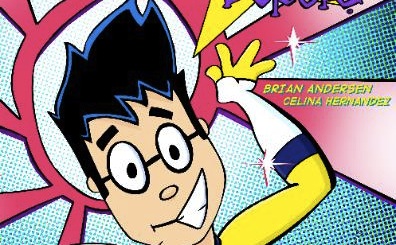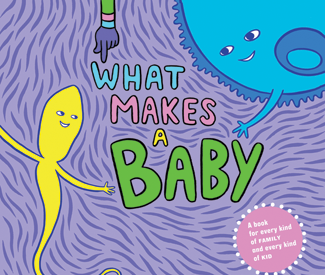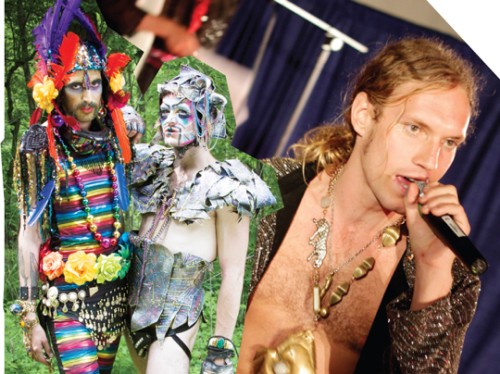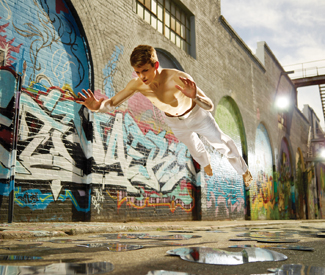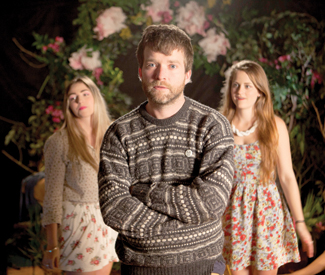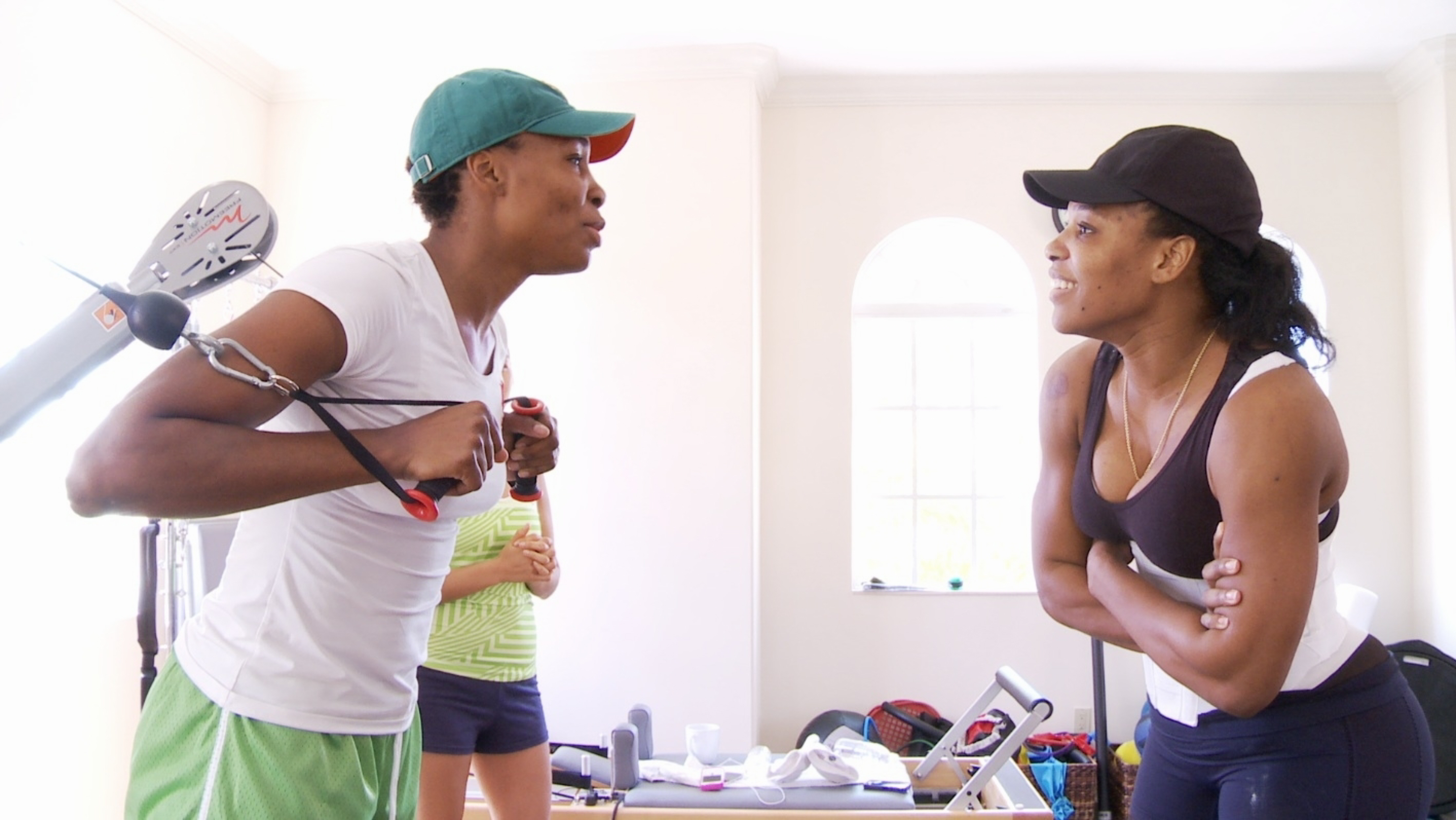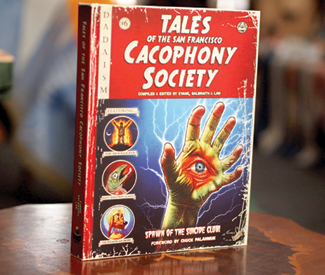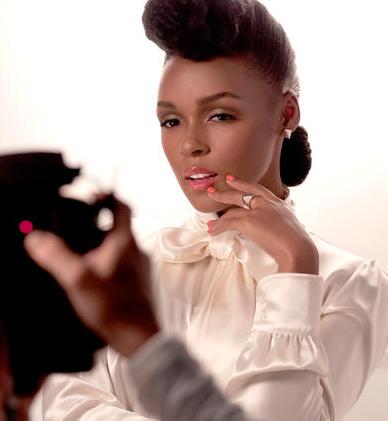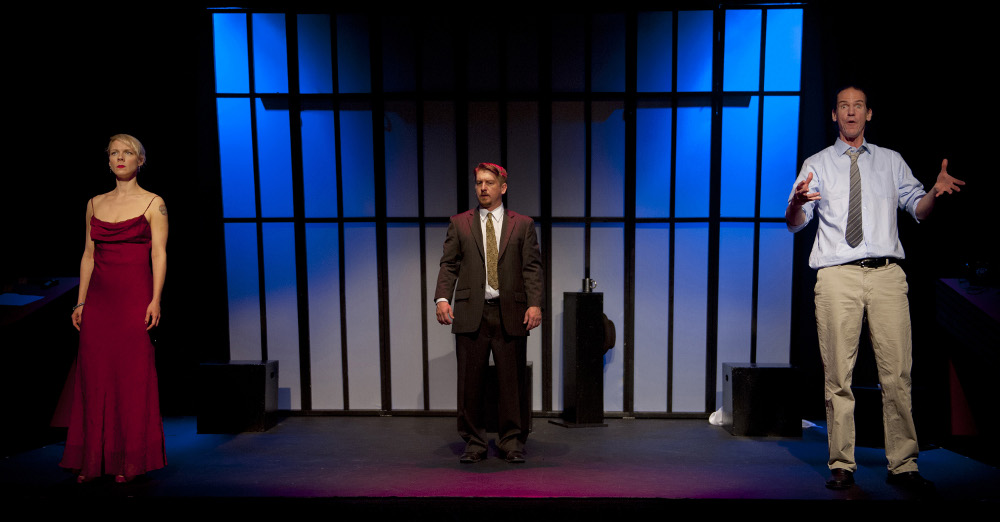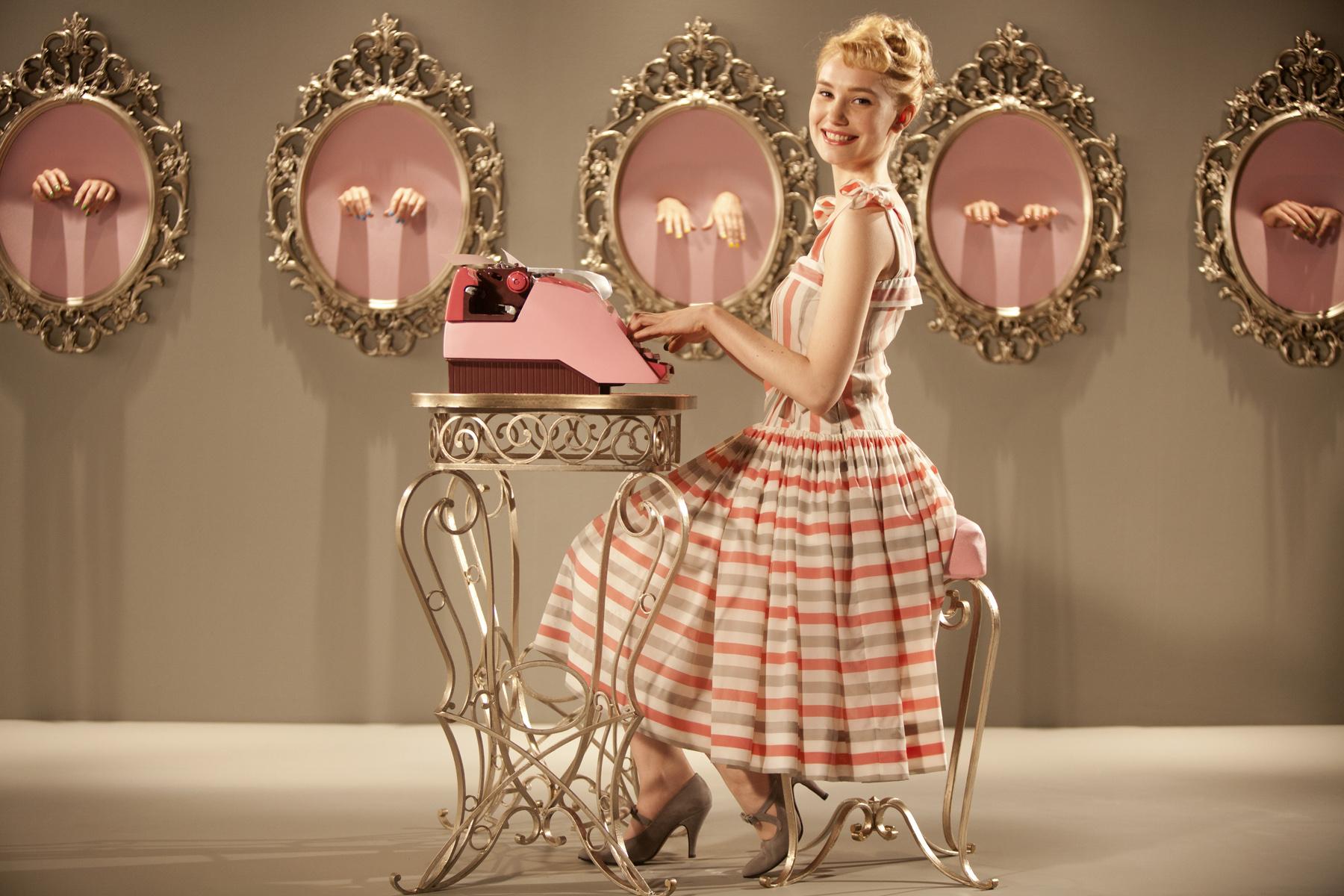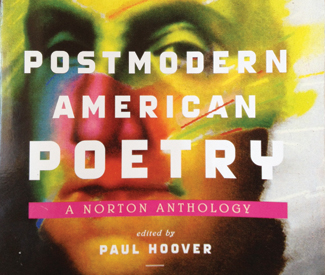WEDNESDAY 3
ROCK
Bottom of the Hill: 1233 17th St., San Francisco, 621-4455. Face to Face, Teenage Bottlerocket, Blacklist Royals, Joshua Black Wilkins, 8 p.m., $20–$25.
Brick & Mortar Music Hall: 1710 Mission, San Francisco, 800-8782. Jaill, Cosmonauts, Disappearing People, Scraper, DJ Joel Gion, 9 p.m., $8–$10.
El Rio: 3158 Mission, San Francisco, 282-3325. The Shape, Pharaohs, After, 8 p.m., $5.
Elbo Room: 647 Valencia, San Francisco, 552-7788. POW!, Mane, Generation Loss, 9 p.m., $5.
Hemlock Tavern: 1131 Polk, San Francisco, 923-0923. Bob Log III, The Okmoniks, Los Vincent Black Shadows, 8:30 p.m., $12–$15.
The Independent: 628 Divisadero, San Francisco, 771-1420. The Revivalists, Finish Ticket, 8 p.m., $13–$15.
The Knockout: 3223 Mission, San Francisco, 550-6994. The Boars, Whoosie What’s It’s, 9:30 p.m.
Milk Bar: 1840 Haight, San Francisco, 387-6455. Down Dirty Shake, We Are the Men, Void Boys, Open Bar: The Band, DJ Moses, 8 p.m., $2.
DANCE
1015 Folsom: 1015 Folsom St., San Francisco, 431-1200. Pantyraid (MartyParty & Ooah), An-Ten-Nae, UltraViolet, WolfBitch, Le Portal, Dov, Jocelyn, Releece, Mihkal, Shawna, 10 p.m., $20–$25 advance.
Cafe Du Nord: 2170 Market, San Francisco, 861-5016. Frankmusik, Ride the Universe, Love Charisse, 9:30 p.m., $8–$10.
The Cafe: 2369 Market, San Francisco, 621-4434. “Sticky Wednesdays,” w/ DJ Mark Andrus, 8 p.m., free.
Cat Club: 1190 Folsom, San Francisco, 703-8964. “Bondage A Go Go,” w/ DJs Damon, Tomas Diablo, & guests, 9:30 p.m., $5–$10, www.bondage-a-go-go.com.
The Cellar: 685 Sutter, San Francisco, 441-5678. “Eye Candy Wednesdays,” 9 p.m., free.
Club X: 715 Harrison, San Francisco, 339-8686. “Electro Pop Rocks: EPR Hearts ‘Murica,” 18+ dance party with B33son, Jays One, Harris Pillton, Drrn, Non Sequitur, M3rc, more, 9 p.m., $10–$20, www.facebook.com/ElectroPopRocks.
F8: 1192 Folsom St., San Francisco, 857-1192. “Housepitality,” w/ Derrick Carter, Miguel Solari, Tyrel Williams, Mike Bee, Joel Conway, 9 p.m., www.housepitalitysf.com.
Harlot: 46 Minna, San Francisco, 777-1077. “Qoöl,” 5 p.m., www.qoolsf.com.
Infusion Lounge: 124 Ellis, San Francisco, 421-8700. “Indulgence,” 10 p.m., www.sebastienpresents.com.
Lookout: 3600 16th St., San Francisco, 703-9751. “What?,” 7 p.m.
MatrixFillmore: 3138 Fillmore, San Francisco, 563-4180. “Innov8,” 8 p.m.
Monarch: 101 6th St., San Francisco, 284-9774. “Soul Phunktion,” w/ resident DJs Kimmy Le Funk, Primo, and M3, 9 p.m.
Q Bar: 456 Castro, San Francisco, 864-2877. “Booty Call,” w/ Juanita More, Joshua J, guests, 9 p.m., $3, www.bootycallwednesdays.com.
Ruby Skye: 420 Mason, San Francisco, 693-0777. Independence Eve Party with Manufactured Superstars, Trevor Simpson, The Schmidt, 18+ event, 9 p.m., $20 advance.
HIP-HOP
Double Dutch: 3192 16th St., San Francisco, 503-1670. “Cash IV Gold,” w/ DJs Kool Karlo, Roost Uno, and Sean G, 10 p.m., free, cash4goldsf.tumblr.com.
Mezzanine: 444 Jessie, San Francisco, 625-8880. “Cream of Beat,” w/ DJs Mind Motion, Ivan, Rolo 1-3, Dark Money, Apollo, Fuze, D-Sharp, Big Von, Shortkut, 4Real, and more, 9 p.m., $20.
Skylark Bar: 3089 16th St., San Francisco, 621-9294. “Mixtape Wednesday,” w/ resident DJs Strategy, Junot, Herb Digs, & guests, 9 p.m., $5, www.myspace.com/seguepresents.
ACOUSTIC
Brick & Mortar Music Hall: 1710 Mission, San Francisco, 800-8782. Fruition, 7 p.m., free.
Cafe Divine: 1600 Stockton, San Francisco, 986-3414. Craig Ventresco & Meredith Axelrod, 7 p.m., free.
Fiddler’s Green: 1333 Columbus, San Francisco, 441-9758. Terry Savastano, Every other Wednesday, 9:30 p.m., free/donation, www.terrysavastano.com.
Plough & Stars: 116 Clement, San Francisco, 751-1122. Jeanie & Chuck’s Bluegrass Country Jam, First Wednesday of every month, 9 p.m., free.
Rickshaw Stop: 155 Fell, San Francisco, 861-2011. Kacey Johansing, Farallons, Assateague, 8 p.m., $10.
JAZZ
Amnesia: 853 Valencia, San Francisco, 970-0012. Gaucho, Eric Garland’s Jazz Session, Dink Dink Dink, 7 p.m., free, www.gauchojazz.com.
Burritt Room: 417 Stockton St., San Francisco, 400-0555. Terry Disley’s Rocking Jazz Trio, 6 p.m., free.
Club Deluxe: 1511 Haight, San Francisco, 552-6949. The Techtonics, Every other Wednesday, 8:30 p.m., free.
Jazz Bistro At Les Joulins: 44 Ellis, San Francisco, 397-5397. Charles Unger Experience, 7:30 p.m., free.
Le Colonial: 20 Cosmo, San Francisco, 931-3600. The Cosmo Alleycats featuring Ms. Emily Wade Adams, 7 p.m., free.
Oz Lounge: 260 Kearny, San Francisco, 399-7999. Hard Bop Collective, 6 p.m., free.
Rasselas Ethiopian Cuisine & Jazz Club: 1534 Fillmore, San Francisco, 346-8696. M.B. Hanif & The Sound Voyagers, 8 p.m.
Revolution Cafe: 3248 22nd St., San Francisco, 642-0474. Michael Parsons Trio, Every other Wednesday, 8:30 p.m., free/donation.
Savanna Jazz Club: 2937 Mission, San Francisco, 285-3369. “Cat’s Corner,” 9 p.m., $10.
Top of the Mark: One Nob Hill, 999 California, San Francisco, 616-6916. Ricardo Scales, Wednesdays, 6:30-11:30 p.m., $5.
Zingari: 501 Post, San Francisco, 885-8850. Suzanna Smith, 7:30 p.m., free.
INTERNATIONAL
Bissap Baobab: 3372 19th St., San Francisco, 826-9287. Timba Dance Party, w/ DJ WaltDigz, 10 p.m., $5.
Boom Boom Room: 1601 Fillmore, San Francisco, 673-8000. Cha-Ching, First Wednesday of every month, 9 p.m., 9pm, 673-8000.
Cafe Cocomo: 650 Indiana, San Francisco, 824-6910. “Bachatalicious,” w/ DJs Good Sho & Rodney, 7 p.m., $5–$10.
Casa Sanchez: 2778 24th St., San Francisco, 282-2400. Urban Deportation Benefit Concert for Encantada Gallery, w/ music by the Mission District Latin Jazz All Stars, plus spoken word by Roberto Hernandez, Carlos Baron, and Alejandro Murguía, 6 p.m., $10.
Make-Out Room: 3225 22nd St., San Francisco, 647-2888. “Frigo-Bar,” international dance party with DJs 2shy-shy & Melt w/U, 8 p.m., free.
Pachamama Restaurant: 1630 Powell, San Francisco, 646-0018. “Cafe LatinoAmericano,” 8 p.m., $5.
Union Square Park: 333 Post, San Francisco, 831-2700. Dalia Marina, 12:30 p.m., free; Fito Reinoso, 6 p.m., free.
BLUES
Biscuits and Blues: 401 Mason, San Francisco, 292-2583. Ian Seagal, 8 & 10 p.m., $15.
SOUL
The Cellar: 685 Sutter, San Francisco, 441-5678. “Color Me Badd,” w/ DJ Matt Haze, Wednesdays, 5-9 p.m.
Lexington Club: 3464 19th St., San Francisco, 863-2052. “Secret Lovers,” w/ DJs Ponyboy, Lil MC, Katie Duck, and Durt, First Wednesday of every month, 9 p.m., free.
Yoshi’s San Francisco: 1330 Fillmore, San Francisco, 655-5600. Johnny Britt, 8 p.m., $19.
THURSDAY 4
ROCK
El Rio: 3158 Mission, San Francisco, 282-3325. Eighth Annual El Rio Big Time Freedom Festival, w/ Golden Void, Wild Eyes, Bobb Saggeth, Couches, Upside Drown, 3 p.m., $8.
Hemlock Tavern: 1131 Polk, San Francisco, 923-0923. Apopka Darkroom, Peace Creep, C-Minus, plus free BBQ starting at 1 p.m., 5 p.m., $5.
The Knockout: 3223 Mission, San Francisco, 550-6994. Creative Adult, Cat Party, The New Flesh, 10 p.m., $7.
DANCE
Abbey Tavern: 4100 Geary, San Francisco, 221-7767. DJ Schrobi-Girl, 10 p.m., free.
Aunt Charlie’s Lounge: 133 Turk, San Francisco, 441-2922. “Tubesteak Connection,” w/ DJ Bus Station John, 9 p.m., $5–$7.
The Cafe: 2369 Market, San Francisco, 621-4434. “¡Pan Dulce!,” 9 p.m., $5, www.clubpapi.com.
Cat Club: 1190 Folsom, San Francisco, 703-8964. “All ’80s Thursdays,” w/ DJs Damon, Steve Washington, Dangerous Dan, and guests, 9 p.m., $6 (free before 9:30 p.m.), www.facebook.com/pages/Thursday-nights-at-Cat-Club/191272240888168.
The Cellar: 685 Sutter, San Francisco, 441-5678. “XO,” w/ DJs Astro & Rose, 10 p.m., $5, www.facebook.com/PartyXO.
Club X: 715 Harrison, San Francisco, 339-8686. “The Crib,” 9:30 p.m., $10, 18+, www.thecribsf.com.
Elbo Room: 647 Valencia, San Francisco, 552-7788. “Afrolicious,” w/ DJs Pleasuremaker, Señor Oz, and live guests, 9:30 p.m., $5–$7, afrolicious.org.
The EndUp: 401 Sixth St., San Francisco, 646-0999. EDMSF Thursdays, 10 p.m., $10 (free before midnight).
F8: 1192 Folsom St., San Francisco, 857-1192. “Beat Church,” w/ resident DJs Neptune & Kitty-D, First Thursday of every month, 10 p.m., $10, www.facebook.com/beatchurch.
Infusion Lounge: 124 Ellis, San Francisco, 421-8700. “I Love Thursdays,” 10 p.m., $10.
Madrone Art Bar: 500 Divisadero, San Francisco, 241-0202. “Night Fever,” 9 p.m., $5 after $10 p.m.
MatrixFillmore: 3138 Fillmore, San Francisco, 563-4180. “Fusion,” w/ DJ Big Bad Bruce, 9 p.m., $5.
Mighty: 119 Utah, San Francisco, 762-0151. “Ritual,” w/ Irie Cartel & guests, 10 p.m., $5–$10, https://www.facebook.com/RitualSF.
Monarch: 101 6th St., San Francisco, 284-9774. “Lights Down Low: Body High Fourth of July Takeover,” w/ Jerome LOL, Samo Sound Boy, DJ Funeral, Joaquin Bartra, 10 p.m., $10–$15 advance.
Q Bar: 456 Castro, San Francisco, 864-2877. “Throwback Thursday,” w/ DJ Jay-R, 9 p.m., free.
Raven: 1151 Folsom St., San Francisco, 431-1151. “1999,” w/ VJ Mark Andrus, 8 p.m., free, www.facebook.com/1999sf.
Rickshaw Stop: 155 Fell, San Francisco, 861-2011. “Popscene,” w/ Giraffage, Mister Lies, Bobby Browser, Popscene DJs, 9:30 p.m., $13–$15, www.popscene-sf.com.
Ruby Skye: 420 Mason, San Francisco, 693-0777. “Awakening,” w/ Ummet Ozcan, 9 p.m., $15–$20 advance.
Temple: 540 Howard, San Francisco, 978-9942. “Solid,” w/ DJ Hero, Kimba, Josh Camacho, Sychosis, 10 p.m., $10.
The Tunnel Top: 601 Bush, San Francisco, 722-6620. “Tunneltop,” DJs Avalon and Derek ease you into the weekend with a cool and relaxed selection of tunes spun on vinyl, 10 p.m., free.
Underground SF: 424 Haight, San Francisco, 864-7386. “Bubble,” 10 p.m., free, https://www.facebook.com/LowerHaightbubble.
Vessel: 85 Campton, San Francisco, 433-8585. “Le Cinéma,” w/ Charles Feelgood, DJ Mes, Jazz-E, 10 p.m., $15–$25.
HIP-HOP
Eastside West: 3154 Fillmore, San Francisco, 885-4000. “Throwback Thursdays,” w/ DJ Madison, 9 p.m., free.
John Colins: 138 Minna, San Francisco, 512-7493. “The Premiere,” video hip-hop party with VDJ T.D. Camp, First Thursday of every month, 9 p.m., $5.
The Parlor: 2801 Leavenworth, San Francisco, 775-5110. “Locals Night Out,” w/ DJ Illy D, 9 p.m., free.
Skylark Bar: 3089 16th St., San Francisco, 621-9294. “Peaches,” w/lady DJs DeeAndroid, Lady Fingaz, That Girl, Umami, Inkfat, and Andre, 10 p.m., free, https://www.facebook.com/pages/Peaches-Lady-DJ-Party/187432938362.
ACOUSTIC
Amnesia: 853 Valencia, San Francisco, 970-0012. Misisipi Mike & The Midnight Gamblers, First Thursday of every month, 9 p.m.
Musicians Union Local 6: 116 Ninth St., San Francisco, 575-0777. San Francisco Singer-Songwriters’ Workshop, hosted by Robin Yukiko, First Thursday of every month, 6:30 p.m., $25 (free for AFM members), www.meetup.com/sfsingersongwritersworkshop.
JAZZ
Blush! Wine Bar: 476 Castro, San Francisco, 558-0893. Doug Martin’s Avatar Ensemble, 7:30 p.m., free, www.dougmartinguitar.com.
Bottle Cap: 1707 Powell, San Francisco, 529-2237. The North Beach Sound with Ned Boynton, Jordan Samuels, and Tom Vickers, 7 p.m., free.
Club Deluxe: 1511 Haight, San Francisco, 552-6949. Michael Parsons, 8:30 p.m., free.
Le Colonial: 20 Cosmo, San Francisco, 931-3600. Steve Lucky & The Rhumba Bums, 7:30 p.m.
The Royal Cuckoo: 3202 Mission, San Francisco, 550-8667. Chris Siebert, 7:30 p.m., free.
Savanna Jazz Club: 2937 Mission, San Francisco, 285-3369. Savanna Jazz Jam with Eddy Ramirez, 7:30 p.m., $5.
Top of the Mark: One Nob Hill, 999 California, San Francisco, 616-6916. Stompy Jones, 7:30 p.m., $10.
Yoshi’s San Francisco: 1330 Fillmore, San Francisco, 655-5600. NaJe, in Yoshi’s lounge, First Thursday of every month, 6:30 p.m., free.
Zingari: 501 Post, San Francisco, 885-8850. Anne O’Brien, First Thursday of every month, 7:30 p.m., free.
INTERNATIONAL
Bissap Baobab: 3372 19th St., San Francisco, 826-9287. “Pa’Lante!,” w/ Juan G, El Kool Kyle, Mr. Lucky, 10 p.m., $5.
Pachamama Restaurant: 1630 Powell, San Francisco, 646-0018. “Jueves Flamencos,” 8 p.m., free.
Rasselas Ethiopian Cuisine & Jazz Club: 1534 Fillmore, San Francisco, 346-8696. Latin Breeze, 8 p.m.
Verdi Club: 2424 Mariposa, San Francisco, 861-5048. The Verdi Club Milonga, w/ Christy Coté, DJ Emilio Flores, guests, 9 p.m., $10–$15, www.christycote.com.
REGGAE
Pissed Off Pete’s: 4528 Mission St., San Francisco, 584-5122. Reggae Thursdays, w/ resident DJ Jah Yzer, 9 p.m., free.
BLUES
Biscuits and Blues: 401 Mason, San Francisco, 292-2583. Todd Wolfe, 6:30 & 10:30 p.m., $15.
Jazz Bistro At Les Joulins: 44 Ellis, San Francisco, 397-5397. Bohemian Knuckleboogie, 7:30 p.m., free.
Lou’s Fish Shack: 300 Jefferson St., San Francisco, 771-5687. Willie G, 8:30 p.m.
FUNK
Yoshi’s San Francisco: 1330 Fillmore, San Francisco, 655-5600. “Funk the Fourth,” w/ The Bernie Worrell Orchestra, 8 p.m., $24.
FRIDAY 5
ROCK
Bottom of the Hill: 1233 17th St., San Francisco, 621-4455. Beta State, Back Pocket Memory, The Material, Fighting the Villain, 8:30 p.m., $10–$12.
Cafe Du Nord: 2170 Market, San Francisco, 861-5016. Human Animation Lab, Scarlet Stoic, Abatis, Station & The Monster, 9:30 p.m., $10.
Elbo Room: 647 Valencia, San Francisco, 552-7788. Federale, Cellar Doors, DJ Joel Gion, 9:30 p.m., $7–$10.
Hemlock Tavern: 1131 Polk, San Francisco, 923-0923. Inferno of Joy, Vans, Pony Fight, 9:30 p.m., $7.
The Independent: 628 Divisadero, San Francisco, 771-1420. Rubblebucket, DRMS, 9 p.m., $15.
Slim’s: 333 11th St., San Francisco, 255-0333. Intronaut, Scale the Summit, Castle, 9 p.m., $15.
DANCE
1015 Folsom: 1015 Folsom St., San Francisco, 431-1200. “Free-Did-It,” w/ Goldie, Ryan Hemsworth, Groundislava, D33J, Nick Melons, Bachelors of Science, DJ Dials, Tchphnx, 10 p.m., free with RSVP, bit.ly/FreeDidIt.
Amnesia: 853 Valencia, San Francisco, 970-0012. “Brass Tax,” w/ resident DJs JoeJoe, Ding Dong, Ernie Trevino, Mace, First Friday of every month, 10 p.m., $5, brasstax.samo.org.
Cafe Flore: 2298 Market, San Francisco, 621-8579. “Kinky Beats,” w/ DJ Sergio, 10 p.m., free, www.sergioaudio.com.
The Cafe: 2369 Market, San Francisco, 621-4434. “Boy Bar,” w/ DJ Matt Consola, 9 p.m., $5, www.guspresents.com/events-2/boy-bar.
Cat Club: 1190 Folsom, San Francisco, 703-8964. “Strangelove: Military Fashion Show,” w/ DJs Tomas Diablo, Joe Radio, Xander, and Fact.50, 9:30 p.m., $7 ($3 before 10 p.m.), www.strangelovesf.com.
The Cellar: 685 Sutter, San Francisco, 441-5678. “F.T.S.: For the Story,” 10 p.m.
DNA Lounge: 375 11th St., San Francisco, 626-1409. “Universe,” 18+ dance party with Frank Nitty, Jays One, Krishna, Harris Pilton, Carlos Alfonzo, Non Sequitur, Cereal Killer, Vano, Sound It Out, Novaspace, Kongee, Ruccus, B_Han, 9 p.m., $5–$15.
The EndUp: 401 Sixth St., San Francisco, 646-0999. “Fever,” 10 p.m., free before midnight.
F8: 1192 Folsom St., San Francisco, 857-1192. “Vintage,” w/ DJ Toph One & guests, 5 p.m., free.
The Grand Nightclub: 520 4th St., San Francisco, 814-3008. “We Rock Fridays,” 9:30 p.m.
Infusion Lounge: 124 Ellis, San Francisco, 421-8700. “Escape Fridays,” 10 p.m., $20, sf.infusionlounge.com.
Lookout: 3600 16th St., San Francisco, 703-9751. “HYSL,” 9 p.m., $3, https://www.facebook.com/THATISDOPE.
Madrone Art Bar: 500 Divisadero, San Francisco, 241-0202. “Dirty Rotten Dance Party,” w/ Kap10 Harris, Shane King, guests, First Friday of every month, 9 p.m., $5.
MatrixFillmore: 3138 Fillmore, San Francisco, 563-4180. “F-Style Fridays,” w/ DJ Jared-F, 9 p.m.
Mezzanine: 444 Jessie, San Francisco, 625-8880. “Future Fridays,” w/ Proxy, Jacques Lu Cont, DJ MyKill, MPHD, 9 p.m., $17.
Mighty: 119 Utah, San Francisco, 762-0151. “Low End Theory,” w/ Aceyalone, Eprom, Azizi Gibson, Natasha Kmeto, Dot, more, 10 p.m., $15–$20, www.lowendtheoryclub.com.
Monarch: 101 6th St., San Francisco, 284-9774. Christian Loeffler, Portable Sunsets, 10 p.m., $12.50–$20 advance, www.blasthaus.com.
Otis: 25 Maiden, San Francisco, N/A. “Femme Fatale,” w/ DJs Loryn, Denise, and Didje Kelli, 9 p.m., $5 (free before 11 p.m.).
Powerhouse: 1347 Folsom, San Francisco, 552-8689. “Nasty,” First Friday of every month, 10 p.m., $5.
Public Works: 161 Erie, San Francisco, 932-0955. “Future Perfect: PAN Label Showcase,” w/ Bill Kouligas, Lee Gamble, Heatsick, NHK’Koyxen, 9 p.m., $10–$15 advance, https://www.facebook.com/FuturePerfectSF; Rob Garza, Afrolicious DJs, Peter Blick, 9:30 p.m., $12–$20.
Q Bar: 456 Castro, San Francisco, 864-2877. “Pump: Worq It Out Fridays,” w/ resident DJ Christopher B, 9 p.m., $3.
Ruby Skye: 420 Mason, San Francisco, 693-0777. Crookers, 9 p.m., $25–$40 advance.
Slate Bar: 2925 16th St., San Francisco, 558-8521. “Haçeteria,” w/ C.L.A.W.S., plus DJs Jason P, Smac, Tristes Tropiques, and Nihar, 10 p.m., $5, https://www.facebook.com/haceteria.
Supperclub San Francisco: 657 Harrison, San Francisco, 348-0900. “The Shindig,” w/ Dulce, Jimmy Bell, Alchemind, OneMoHit, 404, 10 p.m., $10 advance.
Underground SF: 424 Haight, San Francisco, 864-7386. “Bionic,” w/ Joshua Iz, Nikola Baytala, Tyrel Williams, Jason Greer, 10 p.m., $5, https://www.facebook.com/bionicsf.
Vessel: 85 Campton, San Francisco, 433-8585. PeaceTreaty, 10 p.m., $10–$30.
Wish: 1539 Folsom, San Francisco, 278-9474. “Bridge the Gap,” w/ resident DJ Don Kainoa, Fridays, 6-10 p.m., free, www.hawtmusic.com; “Depth,” w/ resident DJs Sharon Buck & Greg Yuen, First Friday of every month, 10 p.m., free.
HIP-HOP
Brick & Mortar Music Hall: 1710 Mission, San Francisco, 800-8782. Skywalkers (Boac & Sunspot Jonz), Pep Love, Okwerdz, Dirtbag Dan, Knobody, Hazel Rose, Rey Resurreccion, Farid Xan, 9 p.m., $8–$10.
EZ5: 682 Commercial, San Francisco, 362-9321. “Decompression,” Fridays, 5-9 p.m.
Nickies: 466 Haight, San Francisco, 255-0300. “First Fridays,” w/ The Whooligan & Dion Decibels, First Friday of every month, 11 p.m., free.
ACOUSTIC
Plough & Stars: 116 Clement, San Francisco, 751-1122. The Up and Down, 9 p.m.
The Sports Basement: 610 Old Mason, San Francisco, 437-0100. “Breakfast with Enzo,” w/ Enzo Garcia, 10 a.m., $5, www.enzogarcia.com.
St. Cyprian’s Episcopal Church: 2097 Turk, San Francisco, 567-1855. First Fridays Song Circle, First Friday of every month, 7 p.m., $5–$10, cyprianscenter.org/arts.
JAZZ
Beach Chalet Brewery & Restaurant: 1000 Great Highway, San Francisco, 386-8439. Johnny Smith, 8 p.m., free.
Bird & Beckett: 653 Chenery, San Francisco, 586-3733. Don Prell’s SeaBop Ensemble, First Friday of every month, 5:30 p.m., free.
Bottle Cap: 1707 Powell, San Francisco, 529-2237. Terry Disley, 5:30 p.m., free.
Jazz Bistro At Les Joulins: 44 Ellis, San Francisco, 397-5397. Charles Unger Experience, 7:30 p.m., free.
Savanna Jazz Club: 2937 Mission, San Francisco, 285-3369. Savanna Jazz Trio, 7 p.m., $5.
Top of the Mark: One Nob Hill, 999 California, San Francisco, 616-6916. Black Market Jazz Orchestra, 9 p.m., $10.
Yoshi’s San Francisco: 1330 Fillmore, San Francisco, 655-5600. Larry Carlton Quartet, 8 & 10 p.m., $25–$32.
Zingari: 501 Post, San Francisco, 885-8850. Joyce Grant, 8 p.m., free.
INTERNATIONAL
Cafe Cocomo: 650 Indiana, San Francisco, 824-6910. Taste Fridays, featuring local cuisine tastings, salsa bands, dance lessons, and more, 7:30 p.m., $15 (free entry to patio), www.tastefridays.com.
The Emerald Tablet: 80 Fresno St., San Francisco, 500-2323. Guatam Tejas Ganeshan, 8 p.m., free.
Little Baobab: 3388 19th St., San Francisco, 643-3558. “Paris-Dakar African Mix Coupe Decale,” 10 p.m.
Pachamama Restaurant: 1630 Powell, San Francisco, 646-0018. Cuban Night with Fito Reinoso, 7:30 & 9:15 p.m., $15–$18.
REGGAE
Gestalt Haus: 3159 16th St., San Francisco, 655-9935. “Music Like Dirt,” 7:30 p.m., free.
Showdown: 10 Sixth St., San Francisco, 255-7920. “How the West Was Won,” w/ Nowtime Sound, First Friday of every month, 10 p.m., free, https://www.facebook.com/pages/Nowtime-Sound/112557594575.
BLUES
Biscuits and Blues: 401 Mason, San Francisco, 292-2583. Big Daddy Cade & The Blues Masters, 8 & 10 p.m., $20.
Boom Boom Room: 1601 Fillmore, San Francisco, 673-8000. Bill Phillippe, 6 p.m., free.
Lou’s Fish Shack: 300 Jefferson St., San Francisco, 771-5687. Bobbie Webb, 8:30 p.m.
FUNK
Amnesia: 853 Valencia, San Francisco, 970-0012. Swoop Unit, First Friday of every month, 6 p.m.
Boom Boom Room: 1601 Fillmore, San Francisco, 673-8000. Wicked Mercies, Groove 8, DJ K-Os, 9:30 p.m., $10 advance.
Make-Out Room: 3225 22nd St., San Francisco, 647-2888. “Loose Joints,” w/ DJs Centipede, Damon Bell, & Tom Thump, 10 p.m., $5, www.tomthump.com.
SOUL
Edinburgh Castle: 950 Geary, San Francisco, 885-4074. “Soul Crush,” w/ DJ Serious Leisure, 10 p.m., free, www.djseriousleisure.com.
The Knockout: 3223 Mission, San Francisco, 550-6994. “Oldies Night,” w/ DJs Primo, Daniel, Lost Cat, friends, First Friday of every month, 10 p.m., $5, www.facebook.com/groups/39432821853.
SATURDAY 6
ROCK
Bender’s: 806 S. Van Ness, San Francisco, 824-1800. Horror-X, RocketShip RocketShip, 10 p.m., $5, https://www.facebook.com/SubliminalSF.
Brick & Mortar Music Hall: 1710 Mission, San Francisco, 800-8782. Callow, Sunbeam Rd., 9 p.m., $10–$12.
Cafe Du Nord: 2170 Market, San Francisco, 861-5016. Miles Schon Band, HIJK, David Luning, 7:30 p.m., $10.
Hemlock Tavern: 1131 Polk, San Francisco, 923-0923. Skunks, Feelings, Low Magic, 9:30 p.m., $6.
The Independent: 628 Divisadero, San Francisco, 771-1420. White Denim, Coo Coo Birds, 9 p.m., $15–$17.
Rickshaw Stop: 155 Fell, San Francisco, 861-2011. The Love Dimension, Zodiac Death Valley, The Lotus Moons, DJ Duke of Windsor, 8 p.m., $10.
Thee Parkside: 1600 17th St., San Francisco, 252-1330. Needles, La URSS, Neon Piss, Street Eaters, 9 p.m., $8.
DANCE
Cafe Flore: 2298 Market, San Francisco, 621-8579. “Bistrotheque,” w/ DJ Ken Vulsion, 8 p.m., free.
Cat Club: 1190 Folsom, San Francisco, 703-8964. “Leisure,” w/ DJs Aaron, Omar, & Jetset James, First Saturday of every month, 10 p.m., $7, www.popscene-sf.com.
DNA Lounge: 375 11th St., San Francisco, 626-1409. “Bootie S.F.,” w/ DJs Faroff, Entyme, John!John!, Fox, Kool Karlo, and Jay-R, 9 p.m., $10–$15, www.bootiesf.com.
The EndUp: 401 Sixth St., San Francisco, 646-0999. “Play,” w/ Joel Mull, Luke Hess, Bob Five, Michael Perry, 10 p.m., $15–$20 (free before 11 p.m.).
Infusion Lounge: 124 Ellis, San Francisco, 421-8700. “Volume,” First Saturday of every month, 10 p.m., $10–$20.
The Knockout: 3223 Mission, San Francisco, 550-6994. “Debaser: Fourth of July Indie Battle,” American indie vs. British indie dance party with DJs EmDee and Jamie Jams, 10 p.m., $5 (free before 11 p.m. if wearing flannel), https://www.facebook.com/debaser90s.
Lookout: 3600 16th St., San Francisco, 703-9751. “Bounce!,” 9 p.m., $3.
Madrone Art Bar: 500 Divisadero, San Francisco, 241-0202. “The Prince & Michael Experience,” w/ DJs Dave Paul & Jeff Harris, First Saturday of every month, 9 p.m., $5, www.bombhiphop.com/PvsM.html.
Mighty: 119 Utah, San Francisco, 762-0151. “Wicked: Return of the Prodigal Sons — 22-Year Showdown,” w/ DJs Garth, Jenö, Markie, and Thomas (continues until 7 a.m.), 10 p.m., $20–$25, wicked22.eventbrite.com.
OMG: 43 6th St., San Francisco, 896-6374. “OMG So Tasty: Dance Party for the Gay and Sexy,” 9 p.m., $10 (free with RSVP), omgsotasty.eventbrite.com.
Project One: 251 Rhode Island, San Francisco, 465-2129. “Rhythm,” w/ Mauricio Aviles, Franky Boissy, Alix Alvarez, 9 p.m., $5 before 10:30 p.m.
Public Works: 161 Erie, San Francisco, 932-0955. “Deep Blue: Leftroom Label Showcase,” w/ Laura Jones, Matt Tolfrey, DJ Rooz, DJ Bo (in the main room), 9:30 p.m., $13–$20.
Q Bar: 456 Castro, San Francisco, 864-2877. “Homo Erectus,” w/ DJs MyKill & Dcnstrct, First Saturday of every month, 9 p.m., $5, www.clubhomoerectus.com.
Ruby Skye: 420 Mason, San Francisco, 693-0777. Ken Loi, Nick G, 9 p.m., $20 advance.
The Stud: 399 Ninth St., San Francisco, 863-6623. “Go Bang!,” w/ DJs Tim Zawada, Chris Orr, Steve Fabus, and Sergio Fedasz, 9 p.m., $7 (free before 10 p.m.), www.gobangsf.com.
Temple: 540 Howard, San Francisco, 978-9942. Suns of Temple, DJ Oons, Kid Alien, Miki Taka, Glitch Report, Hordes, Shizloh, Mr. Kitt, A2D, 10 p.m., $20.
Underground SF: 424 Haight, San Francisco, 864-7386. “Push the Feeling,” w/ Woolfy (DJ set), Bruse, Yr Skull, Epicsauce DJs, 9 p.m., $6, https://www.facebook.com/pushthefeeling.
HIP-HOP
John Colins: 138 Minna, San Francisco, 512-7493. “N.E.W.: Never Ending Weekend,” w/ DJ Jerry Ross, First Saturday of every month, 9 p.m., free before 11 p.m.
Slate Bar: 2925 16th St., San Francisco, 558-8521. “Touchy Feely,” w/ The Wild N Krazy Kids, First Saturday of every month, 10 p.m., $5 (free before 11 p.m.).
Slim’s: 333 11th St., San Francisco, 255-0333. Kottonmouth Kings, X Clan, Imperial Soundclash (Dog Boy & DJ Bobby B), 9 p.m., $21.
ACOUSTIC
Atlas Cafe: 3049 20th St., San Francisco, 648-1047. Craig Ventresco & Meredith Axelrod, Saturdays, 4-6 p.m., free.
Make-Out Room: 3225 22nd St., San Francisco, 647-2888. Zachary Cale, Colossal Yes, 7:30 p.m., $8.
Plough & Stars: 116 Clement, San Francisco, 751-1122. “Americana Jukebox,” w/ The Dull Richards, 9 p.m., $6–$10, www.shelbyashpresents.net/americanaJukebox/americanaJukebox.html.
Revolution Cafe: 3248 22nd St., San Francisco, 642-0474. Seth Augustus, First Saturday of every month, 9 p.m., free/donation.
JAZZ
Center for New Music: 55 Taylor St., San Francisco, 275-2466. Josh Berman & Friends, 7:30 p.m., $8–$12.
Club Deluxe: 1511 Haight, San Francisco, 552-6949. Saturday Afternoon Jazz, w/ Danny Brown, Danny Grewen, Eugene Warren, & Beth Goodfellow, 4:30 p.m., free.
Jazz Bistro At Les Joulins: 44 Ellis, San Francisco, 397-5397. Bill “Doc” Webster & Jazz Nostalgia, 7:30 p.m., free.
Rasselas Ethiopian Cuisine & Jazz Club: 1534 Fillmore, San Francisco, 346-8696. The Robert Stewart Experience, 9 p.m., $7.
Savanna Jazz Club: 2937 Mission, San Francisco, 285-3369. Savanna Jazz Trio, 7 p.m., $5.
Sheba Piano Lounge: 1419 Fillmore, San Francisco, 440-7414. Charles Unger Experience, First Saturday of every month, 8 p.m.
Zingari: 501 Post, San Francisco, 885-8850. Hubert Emerson, 8 p.m., free.
INTERNATIONAL
1015 Folsom: 1015 Folsom St., San Francisco, 431-1200. “Pura,” 9 p.m., $20, www.puraclub.com.
Little Baobab: 3388 19th St., San Francisco, 643-3558. “Paris-Dakar African Mix Coupe Decale,” 10 p.m.
Make-Out Room: 3225 22nd St., San Francisco, 647-2888. “El SuperRitmo,” Latin dance party with DJs Roger Mas & El Kool Kyle, 10 p.m., $5.
Neck of the Woods: 406 Clement St., San Francisco, 387-6343. “Night of Passion,” w/ Viola Jemchug, DJ Bantik, 9 p.m.
Pachamama Restaurant: 1630 Powell, San Francisco, 646-0018. Peña Eddy Navia & Pachamama Band, 8 p.m., free.
Porto Franco Art Parlor: 953 Valencia, San Francisco, 826-2526. Tangonero, 8 p.m., $25.
Yerba Buena Gardens: Fourth St. & Mission, San Francisco, 284-9589. “Accordion Daze,” w/ Big Lou’s Dance Party, La Familia Peña-Govea, The Gonifs, noon, free.
REGGAE
The Riptide: 3639 Taraval, San Francisco, 759-7263. Riptide Ninth Annual Birthday Party with the Titan Ups, 9 p.m., free.
BLUES
Biscuits and Blues: 401 Mason, San Francisco, 292-2583. Big Daddy Cade & The Blues Masters, 7:30 & 10 p.m., $20.
Lou’s Fish Shack: 300 Jefferson St., San Francisco, 771-5687. Nat Bolden, 8:30 p.m.
EXPERIMENTAL
Adobe Books: 3130 24th St., San Francisco, 864-3936. Soundwave ((6)) SonicLAB: AudioBus — Mission Creek, A roving tour of the neighborhood where the long-lost Mission Creek once ran, with narration and sounds by Andrew McKinley, Jeff Ray, and Jorge Bachmann, 8 & 9 p.m., $16, projectsoundwave.me-di-ate.net.
FUNK
Boom Boom Room: 1601 Fillmore, San Francisco, 673-8000. Steppin’, July 6-7, noon, free.
SOUL
Boom Boom Room: 1601 Fillmore, San Francisco, 673-8000. “Soul Train Revival,” w/ “Ziek” McCarter & The Soul System, 9:30 p.m., $10 advance.
El Rio: 3158 Mission, San Francisco, 282-3325. “Hard French,” w/ DJs Carnita & Brown Amy, First Saturday of every month, 2 p.m., $7, www.hardfrench.com.
Elbo Room: 647 Valencia, San Francisco, 552-7788. “Saturday Night Soul Party,” w/ DJs Lucky, Phengren Oswald, & Paul Paul, First Saturday of every month, 10 p.m., $10 ($5 in formal attire), www.totalshutdown.com/SOULNIGHT/.
Yoshi’s San Francisco: 1330 Fillmore, San Francisco, 655-5600. Teedra Moses, 8 & 10 p.m., $23–$28.
SUNDAY 7
ROCK
Bottom of the Hill: 1233 17th St., San Francisco, 621-4455. You Are Plural, Wild Ones, Li Xi, 9 p.m., $8.
BrainWash Cafe & Laundromat: 1122 Folsom, San Francisco, 861-3663. Really Realtors, Daniel Ouellette & The Shobijin, Silke Berlinn & The Addictions, 6 p.m., free.
DNA Lounge: 375 11th St., San Francisco, 626-1409. Monsters Scare You, Speaking the King’s, Set to Reflect, 7 p.m., $10–$12.
El Rio: 3158 Mission, San Francisco, 282-3325. Roland, bWrek, Skyscraper Mori, 8 p.m., $6.
Hemlock Tavern: 1131 Polk, San Francisco, 923-0923. Twin Steps, Hausu, FF, 8:30 p.m., $7.
Thee Parkside: 1600 17th St., San Francisco, 252-1330. Lenz, Pure Bliss, Tiaras, ProFan DJs, 8 p.m., $6.
DANCE
The Cellar: 685 Sutter, San Francisco, 441-5678. “Replay Sundays,” 9 p.m., free.
The Edge: 4149 18th St., San Francisco, 863-4027. “’80s at 8,” w/ DJ MC2, 8 p.m.
The EndUp: 401 Sixth St., San Francisco, 646-0999. “T.Dance,” 6 a.m.-6 p.m.; “BoomBox,” First Sunday of every month, 8 p.m.; “Sunday Sessions,” 8 p.m.
F8: 1192 Folsom St., San Francisco, 857-1192. “Stamina Sundays,” w/ DJs Lukeino, Jamal, and guests, 10 p.m., free, www.staminasundays.com.
Holy Cow: 1535 Folsom, San Francisco, 621-6087. “Honey Sundays,” w/ Honey Soundsystem & guests, 9 p.m., $5, www.honeysoundsystem.com.
The Knockout: 3223 Mission, San Francisco, 550-6994. “Sweater Funk,” 10 p.m., free, www.facebook.com/sweaterfunk.
Lookout: 3600 16th St., San Francisco, 703-9751. “Jock,” Sundays, 3-8 p.m., $2.
Otis: 25 Maiden, San Francisco, N/A. “What’s the Werd?,” w/ resident DJs Nick Williams, Kevin Knapp, Maxwell Dub, and guests, 9 p.m., $5 (free before 11 p.m.), www.werd-sf.com.
The Parlor: 2801 Leavenworth, San Francisco, 775-5110. DJ Marc deVasconcelos, 10 p.m., free.
Q Bar: 456 Castro, San Francisco, 864-2877. “Gigante,” 8 p.m., free.
Temple: 540 Howard, San Francisco, 978-9942. “Sunset Arcade,” 18+ dance party with bar games and video arcade, 7 p.m., $5, www.facebook.com/ElectroPopRocks.
HIP-HOP
El Rio: 3158 Mission, San Francisco, 282-3325. “Swagger Like Us,” First Sunday of every month, 3 p.m.
Skylark Bar: 3089 16th St., San Francisco, 621-9294. “Shooz,” w/ DJ Raymundo & guests, First Sunday of every month, 10 p.m., free.
ACOUSTIC
Bazaar Cafe: 5927 California, San Francisco, 831-5620. Bugs in Costumes, First Sunday of every month, 6 p.m., free.
Club Deluxe: 1511 Haight, San Francisco, 552-6949. Musical Mayhem with the Dimestore Dandy, 5:30 p.m., free, www.facebook.com/event.php?eid=147309448667349.
The Lucky Horseshoe: 453 Cortland, San Francisco. Sunday Bluegrass Jam, 4 p.m., free; The Cherry Pickers, 8 p.m.
Milk Bar: 1840 Haight, San Francisco, 387-6455. Parlor Tricks, Skidanenko-Green Bluegrass Duet, 4 p.m., free.
Neck of the Woods: 406 Clement St., San Francisco, 387-6343. “iPlay,” open mic with featured weekly artists, 6:30 p.m., free, https://www.facebook.com/neckofthewoods.openmic.
Plough & Stars: 116 Clement, San Francisco, 751-1122. Seisiún with Marla Fibish, 9 p.m.
St. Luke’s Episcopal Church: 1755 Clay, San Francisco. “Sunday Night Mic,” w/ Roem Baur, 5 p.m., free, www.facebook.com/SundayNightMic.
JAZZ
Amnesia: 853 Valencia, San Francisco, 970-0012. Kally Price Old Blues & Jazz Band, First Sunday of every month, 9 p.m., $5.
Club Deluxe: 1511 Haight, San Francisco, 552-6949. Jay Johnson, 9 p.m., free.
Jazz Bistro At Les Joulins: 44 Ellis, San Francisco, 397-5397. Bill “Doc” Webster & Jazz Nostalgia, 7:30 p.m., free.
Madrone Art Bar: 500 Divisadero, San Francisco, 241-0202. “Sunday Sessions,” 10 p.m., free.
Musicians Union Local 6: 116 Ninth St., San Francisco, 575-0777. Noertker’s Moxie, Architect/Enchantress, 7:30 p.m., $8–$10.
Revolution Cafe: 3248 22nd St., San Francisco, 642-0474. Jazz Revolution, 4 p.m., free/donation.
The Royal Cuckoo: 3202 Mission, San Francisco, 550-8667. Lavay Smith & Chris Siebert, 7:30 p.m., free.
Zingari: 501 Post, San Francisco, 885-8850. Barbara Ochoa, 7:30 p.m., free.
INTERNATIONAL
Atmosphere: 447 Broadway, San Francisco, 788-4623. “Hot Bachata Nights,” w/ DJ El Guapo, 5:30 p.m., $10 ($15–$20 with dance lessons), www.hotbachatanights.com.
Bissap Baobab: 3372 19th St., San Francisco, 826-9287. “Brazil & Beyond,” 6:30 p.m., free.
Oasis Bar & Grill: 401 California Ave., San Francisco, 765-1900. “El Vacilón,” 4 p.m., $10.
Thirsty Bear Brewing Company: 661 Howard, San Francisco, 974-0905. “The Flamenco Room,” 7:15 & 8:30 p.m.
Yoshi’s San Francisco: 1330 Fillmore, San Francisco, 655-5600. Trio Voronezh, 7 p.m., $24–$40.
REGGAE
Elbo Room: 647 Valencia, San Francisco, 552-7788. “Dub Mission,” w/ DJs Sep, Green B, and Daneekah, 9 p.m., $6 (free before 9:30 p.m.), dubmissionsf.com.
BLUES
Biscuits and Blues: 401 Mason, San Francisco, 292-2583. Big Daddy Cade & The Blues Masters, 7 & 9:30 p.m., $20.
Revolution Cafe: 3248 22nd St., San Francisco, 642-0474. HowellDevine, 8:30 p.m., free/donation.
The Saloon: 1232 Grant, San Francisco, 989-7666. Blues Power, 4 p.m.
Sheba Piano Lounge: 1419 Fillmore, San Francisco, 440-7414. Bohemian Knuckleboogie, 9 p.m., free.
COUNTRY
The Riptide: 3639 Taraval, San Francisco, 759-7263. “The Hootenanny West Side Revue,” First Sunday of every month, 7:30 p.m., free, https://www.facebook.com/pages/The-Hootenanny-West-Side-Revue-First-Sundays/341248372565054.
Tupelo: 1337 Green St., San Francisco, 981-9177. “Twang Sunday,” 4 p.m., free.
FUNK
Boom Boom Room: 1601 Fillmore, San Francisco, 673-8000. Steppin’, July 6-7, noon, free.
SOUL
Boom Boom Room: 1601 Fillmore, San Francisco, 673-8000. “Deep Fried Soul,” w/ DJs Boombostic & Soul Sauce, 9:30 p.m., $5.
Delirium Cocktails: 3139 16th St., San Francisco, 552-5525. “Heart & Soul,” w/ DJ Lovely Lesage, 10 p.m., free, www.facebook.com/heartandsoulsunday.
MONDAY 8
ROCK
Cafe Du Nord: 2170 Market, San Francisco, 861-5016. Kelly Jones, The Real Numbers, The Corner Laughers, Melanie Penn, 7:30 p.m., $10–$12.
The Independent: 628 Divisadero, San Francisco, 771-1420. The Oblivians, Musk, Midnite Snaxxx, Primitive Hearts, 8 p.m., $25.
DANCE
DNA Lounge: 375 11th St., San Francisco, 626-1409. “Death Guild,” 18+ dance party with DJs Decay, Joe Radio, Melting Girl, & guests, 9:30 p.m., $3–$5, www.deathguild.com.
Playland Bar: 1351 Polk St., San Francisco, 440-7529. “Nightcall,” w/ DJs Don Lynch & Scotty Fox, 9 p.m., free.
Q Bar: 456 Castro, San Francisco, 864-2877. “Wanted,” w/ DJs Key&Kite and Richie Panic, 9 p.m., free.
Underground SF: 424 Haight, San Francisco, 864-7386. “Vienetta Discotheque,” w/ DJs Stanley Frank and Robert Jeffrey, 10 p.m., free.
ACOUSTIC
Amnesia: 853 Valencia, San Francisco, 970-0012. The Pick Bluegrass Jam, Second Monday of every month, 6 p.m., free, www.thepicksf.com/jam.aspx; Toshio Hirano, Second Monday of every month, 9 p.m., free, www.toshiohirano.com.
The Chapel: 777 Valencia St., San Francisco. Jeffrey Lewis with Jaimee Garbacik, Odawas, live music + non-fiction lit reading, 9 p.m., $12.
The Chieftain: 198 Fifth St., San Francisco, 615-0916. The Wrenboys, 7 p.m., free.
Fiddler’s Green: 1333 Columbus, San Francisco, 441-9758. Terry Savastano, 9:30 p.m., free/donation, www.terrysavastano.com.
Hotel Utah: 500 Fourth St., San Francisco, 546-6300. Open mic with Brendan Getzell, 8 p.m., free.
Osteria: 3277 Sacramento, San Francisco, 771-5030. “Acoustic Bistro,” 7 p.m., free, www.kcturnerpresents.com.
JAZZ
Le Colonial: 20 Cosmo, San Francisco, 931-3600. Le Jazz Hot, 7 p.m., free.
Rasselas Ethiopian Cuisine & Jazz Club: 1534 Fillmore, San Francisco, 346-8696. Open Mic Jazz Jam with Tod Dickow, 8 p.m.
The Union Room at Biscuits and Blues: 401 Mason, San Francisco, 931-6012. “The Session: A Monday Night Jazz Series,” pro jazz jam with Mike Olmos, 7:30 p.m., $12.
Zingari: 501 Post, San Francisco, 885-8850. Nora Maki, 7:30 p.m., free.
INTERNATIONAL
Elbo Room: 647 Valencia, San Francisco, 552-7788. “Balkan Brass & Eastern Grüve,” w/ DJ Baron Von East-Infection, 9 p.m., $3, https://www.facebook.com/BALKANBRASSANDEASTERNGROOVE.
REGGAE
Skylark Bar: 3089 16th St., San Francisco, 621-9294. “Skylarking,” w/ I&I Vibration, 10 p.m., free.
BLUES
Jazz Bistro At Les Joulins: 44 Ellis, San Francisco, 397-5397. Bohemian Knuckleboogie, 7:30 p.m., free.
The Saloon: 1232 Grant, San Francisco, 989-7666. The Bachelors, 9:30 p.m.
SOUL
Madrone Art Bar: 500 Divisadero, San Francisco, 241-0202. “M.O.M. (Motown on Mondays),” w/ DJ Gordo Cabeza & Timoteo Gigante, 8 p.m., free, www.motownonmondays.com.
TUESDAY 9
ROCK
Bottom of the Hill: 1233 17th St., San Francisco, 621-4455. Mad Caddies, Flexx Bronco, The Breaks, 9 p.m., $15–$18.
Cafe Du Nord: 2170 Market, San Francisco, 861-5016. Gentlemen Hall, Nova Albion, Rin Tin Tiger, 9 p.m., $7.
The Chapel: 777 Valencia St., San Francisco. Deep Time, Dylan Shearer, 9 p.m., $12.
The Knockout: 3223 Mission, San Francisco, 550-6994. Los Headaches, Machos Borrachos, The Lost Luvs, The Shanghais, DJ Phil In, 9:30 p.m., $7.
DANCE
Aunt Charlie’s Lounge: 133 Turk, San Francisco, 441-2922. “High Fantasy,” w/ DJ Viv, Myles Cooper, & guests, 10 p.m., $2, www.facebook.com/highfantasy.
The Independent: 628 Divisadero, San Francisco, 771-1420. Future Bible Heroes, Luxury Liners, 8 p.m., $15.
MatrixFillmore: 3138 Fillmore, San Francisco, 563-4180. “TRL,” w/ DJ Big Bad Bruce, 10 p.m.
Q Bar: 456 Castro, San Francisco, 864-2877. “Switch,” w/ DJs Jenna Riot & Andre, 9 p.m., $3.
Underground SF: 424 Haight, San Francisco, 864-7386. “Shelter,” 10 p.m., free, www.facebook.com/shelter.sf.
Wish: 1539 Folsom, San Francisco, 278-9474. “Tight,” w/ resident DJs Michael May & Lito, 8 p.m., free.
HIP-HOP
Double Dutch: 3192 16th St., San Francisco, 503-1670. “Takin’ It Back Tuesdays,” w/ DJs Mr. Murdock and Roman Nunez, Second Tuesday of every month, 10 p.m., free.
Skylark Bar: 3089 16th St., San Francisco, 621-9294. “True Skool Tuesdays,” w/ DJ Ren the Vinyl Archaeologist, 10 p.m., free, www.trueskool.com.
ACOUSTIC
Bazaar Cafe: 5927 California, San Francisco, 831-5620. Songwriter-in-Residence: Alan Monasch, 7 p.m. continues through July 30.
Bottle Cap: 1707 Powell, San Francisco, 529-2237. Craig Ventresco, 7 p.m.
Plough & Stars: 116 Clement, San Francisco, 751-1122. Seisiún with Barry O’Connell & Vinnie Cronin, 9 p.m.
JAZZ
Beach Chalet Brewery & Restaurant: 1000 Great Highway, San Francisco, 386-8439. Gerry Grosz Jazz Jam, 7 p.m.
Burritt Room: 417 Stockton St., San Francisco, 400-0555. Terry Disley’s Rocking Jazz Trio, 6 p.m., free.
Cafe Divine: 1600 Stockton, San Francisco, 986-3414. Chris Amberger, 7 p.m.
Club Deluxe: 1511 Haight, San Francisco, 552-6949. Eugene Warren Trio, 8:30 p.m., free.
Jazz Bistro At Les Joulins: 44 Ellis, San Francisco, 397-5397. M.B. Hanif & The Sound Voyagers, 7:30 p.m., free.
Oz Lounge: 260 Kearny, San Francisco, 399-7999. Emily Hayes & Mark Holzinger, 6 p.m., free, www.emilyhayes.com.
Revolution Cafe: 3248 22nd St., San Francisco, 642-0474. West Side Jazz Club, 5 p.m., free.
Verdi Club: 2424 Mariposa, San Francisco, 861-5048. “Tuesday Night Jump,” w/ Stompy Jones, 9 p.m., $10–$12, www.tuesdaynightjump.com.
Yoshi’s San Francisco: 1330 Fillmore, San Francisco, 655-5600. Tommy Igoe Big Band, 8 p.m., $22.
Zingari: 501 Post, San Francisco, 885-8850. Sherri Roberts, 7:30 p.m., free.
INTERNATIONAL
Bissap Baobab: 3372 19th St., San Francisco, 826-9287. “Underground Nomads,” w/ rotating resident DJs Cheb i Sabbah, Amar, Sep, and Dulce Vita, 10 p.m., $5, https://www.facebook.com/UndergroundNomads.
The Cosmo Bar & Lounge: 440 Broadway, San Francisco, 989-3434. “Conga Tuesdays,” 8 p.m., $7–$10.
REGGAE
Milk Bar: 1840 Haight, San Francisco, 387-6455. “Bless Up,” w/ Jah Warrior Shelter Hi-Fi, 10 p.m., www.jahwarriorshelter.com.
BLUES
Biscuits and Blues: 401 Mason, San Francisco, 292-2583. Tia Carroll & Hard Work, 8 & 10 p.m., $15.
Rasselas Ethiopian Cuisine & Jazz Club: 1534 Fillmore, San Francisco, 346-8696. Bohemian Knuckleboogie, 8 p.m., free.
EXPERIMENTAL
Center for New Music: 55 Taylor St., San Francisco, 275-2466. sfSoundSalonSeries, w/ Michal Rataj, Andy Claussen’s Wishbone Project, 7:49 p.m., $7–$10, www.sfsound.org/series.
Hemlock Tavern: 1131 Polk, San Francisco, 923-0923. Night Worship, A.C. Way, 8:30 p.m., $7.
FUNK
Madrone Art Bar: 500 Divisadero, San Francisco, 241-0202. “Boogaloo Tuesday,” w/ Oscar Myers & Steppin’, 9:30 p.m., $2, https://www.facebook.com/events/213988081953274.
SOUL
Make-Out Room: 3225 22nd St., San Francisco, 647-2888. “Lost & Found,” w/ DJs Primo, Lucky, and guests, 9:30 p.m., free, 647-2888.


